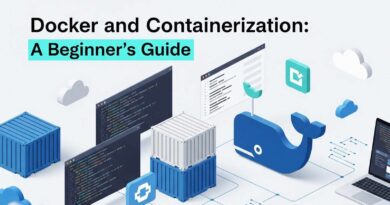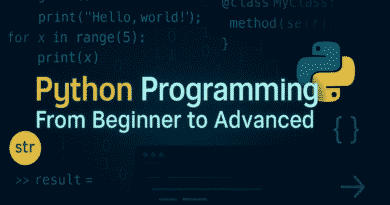Infrastructure as Code with Terraform — Beginner to Advanced
Infrastructure as Code (IaC) with Terraform: Complete End-to-End Guide
🧾 Introduction to Infrastructure as Code (IaC) – Why It Matters
Infrastructure as Code (IaC) is the practice of managing and provisioning computing infrastructure through machine-readable definition files, rather than physical hardware configuration or interactive tools. Think of it as writing code to describe your servers, networks, databases, and more — then running that code to automatically build and manage those resources.
Why IaC Is a Game-Changer:
-
Speed: Infrastructure that once took days or weeks to provision can now be deployed in minutes.
-
Consistency: Same configuration applied across multiple environments (development, testing, production) eliminates human errors and environment drift.
-
Version Control: Infrastructure definitions live alongside your application code in repositories like Git, enabling tracking, auditing, and rollbacks.
-
Collaboration: Developers, DevOps, and operations teams collaborate seamlessly on infrastructure changes.
-
Automation: IaC enables fully automated deployment pipelines, improving efficiency and reducing manual effort.
-
Disaster Recovery: Quickly rebuild entire environments in the event of failures using versioned configs.
Drawbacks and Challenges:
-
Learning Curve: Requires understanding of declarative languages and cloud APIs.
-
State Management: Keeping track of what infrastructure currently exists can be tricky and must be managed carefully.
-
Complex Debugging: Errors during provisioning can sometimes be difficult to interpret.
-
Security: Secrets like API keys and passwords need to be managed securely outside of code.
Real-World Example:
A fast-growing startup uses IaC to replicate their entire production environment in a sandbox for testing new features. This reduces bugs and accelerates their release cycles.
Also Read,
| Kubernetes and CI/CD: The Complete Beginner’s Guide |
🛠️ Getting Started with Terraform
Terraform by HashiCorp is one of the most widely used IaC tools, known for its declarative syntax and provider-agnostic capabilities.
What Makes Terraform Special?
-
Multi-Cloud Support: Use the same tool to provision AWS, GCP, Azure, Kubernetes, and more.
-
Declarative Configuration: You describe what infrastructure you want, not how to build it.
-
Execution Plan: Terraform previews changes so you can review before applying.
-
Infrastructure Lifecycle Management: Create, update, and destroy infrastructure safely.
Basic Workflow:
-
Write configuration files in HashiCorp Configuration Language (HCL).
-
Initialize Terraform in your project directory (
terraform init). -
Generate and review execution plan (
terraform plan). -
Apply changes to provision infrastructure (
terraform apply). -
Manage and update infrastructure using updated configs.
Advantages:
-
Unified tool for managing infrastructure.
-
Rich ecosystem of community modules.
-
Supports complex setups with dependencies.
-
Integrates well with CI/CD pipelines.
Disadvantages:
-
State file management can be complex.
-
Large configurations require good structuring.
-
Limited native testing capabilities.
📦 Writing Your First Terraform Script: Step-by-Step
Let’s create a simple AWS EC2 instance to grasp Terraform basics.
Step-1: Configure the Provider
Tell Terraform which cloud and region you want:
Step-2: Define a Resource
This describes the infrastructure piece:
Step-3: Initialize Terraform
Run this once per project:
Step-4: Preview the Plan
Check what will be created:
Step-5: Apply the Configuration
Execute to provision the instance:
Step-6: Destroy Infrastructure (optional)
Remove created resources to avoid charges:
🌍 Provisioning Infrastructure on AWS and GCP with Terraform
Terraform supports multiple cloud providers with dedicated providers.
AWS Example: Creating an S3 Bucket
GCP Example: Launching a Compute Instance
Important Notes:
-
Cloud providers have API rate limits; batching and retry logic can be needed.
-
Resource dependencies must be respected.
-
Always use least-privilege access permissions for Terraform credentials.
🔁 Understanding Terraform State, Modules, and Workspaces
Terraform State
Terraform maintains a state file (terraform.tfstate) that maps your configuration to real-world resources.
-
This enables it to know which resources exist and track changes.
-
Remote state storage (e.g., AWS S3 with DynamoDB locking) is recommended for team collaboration to avoid conflicts.
Example remote state config:
Modules
Modules are reusable infrastructure code blocks that help organize and share configurations.
Example usage of a VPC module:
Modules improve code maintainability and reuse.
Workspaces
Terraform workspaces allow managing multiple environments (dev, staging, prod) using the same configuration but separate states.
Commands:
🔒 Terraform Security Best Practices
-
Never commit secrets to code repositories. Use secret managers like HashiCorp Vault or cloud-native services.
-
Use IAM roles with least privilege for Terraform to minimize risks.
-
Secure your Terraform state files by using encrypted remote backends.
-
Review infrastructure changes via pull requests and manual approvals.
-
Enable audit logging on cloud provider accounts.
🔄 Integrating Terraform with CI/CD Pipelines
Automation with CI/CD ensures infrastructure changes are tested and applied reliably.
Typical Pipeline Stages:
-
Lint and format code: Use
terraform fmtandtflint. -
Validate configuration: Run
terraform validate. -
Plan and review: Generate
terraform planoutput and allow manual review. -
Apply changes: After approval, run
terraform apply.
Example using GitHub Actions:
✅ Testing and Validation Tools for Terraform
While Terraform itself has basic validation, you can enhance confidence using:
-
tflint: Linting tool to catch issues early.
-
terraform validate: Checks syntax correctness.
-
terratest: Go library for writing unit and integration tests for infrastructure.
-
checkov: Static analysis to detect security issues.
Summary
Terraform is a powerful and flexible IaC tool that helps teams automate infrastructure deployment across cloud platforms efficiently and securely. By mastering Terraform from writing your first script to managing complex multi-environment architectures and integrating with CI/CD pipelines, you unlock the potential to accelerate your infrastructure management, reduce errors, and scale effortlessly.
Whether you’re a beginner or an advanced practitioner, adopting Terraform for IaC is a crucial step towards modern, reliable cloud operations.
📤 Stay Updated with NextGen Careers Hub
📱 Follow us on Instagram
📺 Subscribe us on YouTube
Please share our website with others: NextGenCareersHub.in





